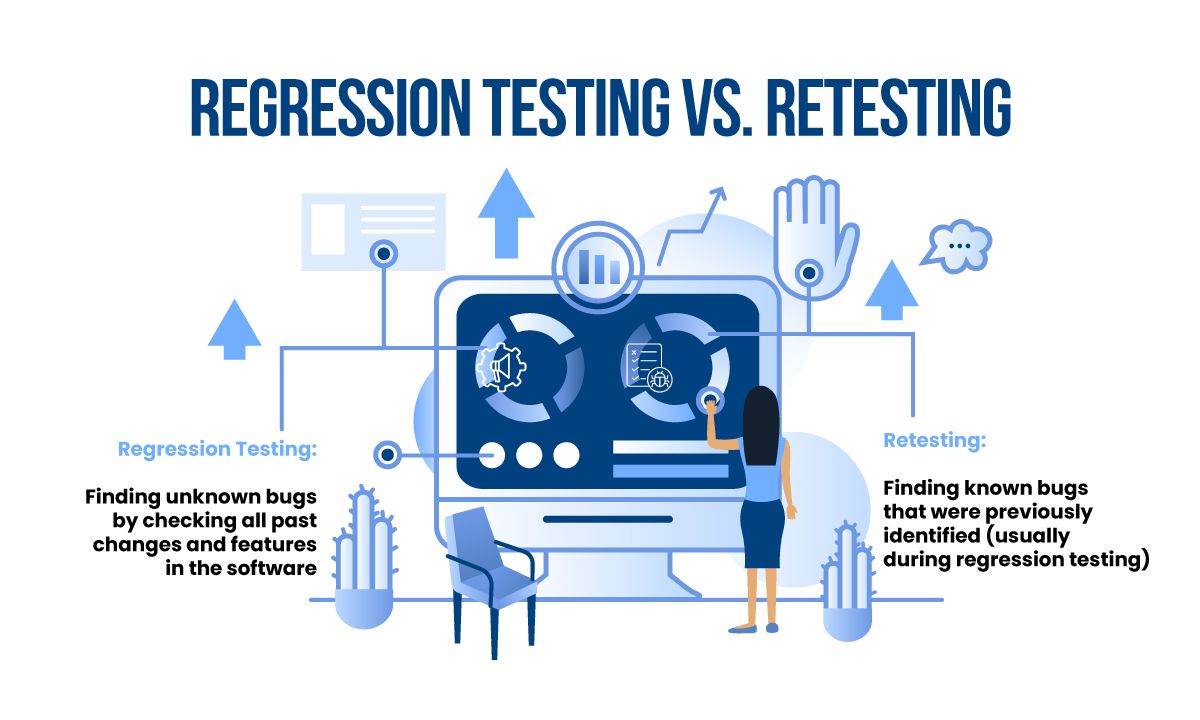

Our Services
Test Automation ServicesAI & Machine LearningBlockchainCRM ConsultingData Science & EngineeringDevOpsDigital MarketingDigital TransformationEmbedded Software DevelopmentERP Consulting ServicesManaged IT ServicesMergers & Acquisitions AdvisoryQA And Testing ServicesRobotic Process Automation SAP Consulting DevelopmentSoftware and Application DevelopmentSQL ConsultingStrategy ConsultingSustainability
- Contact Us
Our Services
- Test Automation Services
- AI & Machine Learning
- Blockchain
- CRM Consulting
- Data Science & Engineering
- DevOps
- Digital Marketing
- Digital Transformation
- Embedded Software Development
- ERP Consulting Services
- Managed IT Services
- Mergers & Acquisitions Advisory
- QA And Testing Services
- Robotic Process Automation
- SAP Consulting Development
- Software and Application Development
- SQL Consulting
- Strategy Consulting
- Sustainability
Insight
Company
Industries
- Contact Us

Retesting and Regression Testing: Comparison Table | Examples
Get ready to learn all about retesting and regression testing and, of course —the difference between retesting and regression testing.
- insight
- /
- blog
- /
- retesting-and-regression-testing
One of the main goals of software development is to ensure that the final product meets the needs of its target audience. To ensure customer satisfaction, it is important to ensure that the software is reliable and delivers high-quality content.
Software testing is one of the most important parts of building a product that people can trust.
You have just completed the intended testing of a new feature, and it is now set to launch.
But first, make sure that the new code hasn't broken anything else in the system.
Regression and retesting come into play here. However, what is the distinction between them?
Retesting and regression testing sound similar, and they are frequently confused. The main difference is that regression testing looks for bugs you did not expect, while retesting looks for bugs you did expect.
While retesting and regression testing are both essential components of the software testing life cycle, there are significant differences in how, when, and why each test is conducted.
Welcome aboard, and get ready to learn all about retesting and regression testing and, of course — the difference between retesting and regression testing.
Highlights
- Retesting focuses on verifying the resolution of specific known defects, while regression testing aims to find unexpected issues caused by changes.
- Regression testing covers the entire system or subsets for overall functionality, while retesting targets specific parts for defect verification.
- Retesting is used to confirm correct functionality of specific parts or modules.
- Regression testing includes passed test cases; retesting involves only failed test cases.

What is Regression Testing?
Regression testing in software testing is important. But why? Let’s look at the regression testing meaning.
Regression testing is a type of software testing that focuses on verifying that recent code changes or updates to a software application have not introduced new defects or caused unintended side effects in previously tested functionality.
The main goal of regression testing is to ensure that the existing features and functionalities of the software continue to work as expected after changes have been made. Shortly, it checks if everything still works after you make changes, so the software does what you want it to do.
If you want to learn more about regression testing, read our comprehensive guide on regression testing meaning and regression testing example.
Smoke and Sanity testing are types of regression testing. They check both how things work and how they don't. But when we add new parts, we don't test them this way because we've already tested them fully.
Knowing why regression testing matters will help you use it well when you're working on your project. Let’s look at a regression testing example to understand it better.
Imagine you are part of a software development team working on an e-commerce website. Your team has recently made updates to the checkout process to improve its performance and user experience. However, you want to make sure that these changes have not caused any unintended bugs elsewhere on the website.
Here's how regression testing could be applied in this scenario:
- Before the updates were made to the checkout process, the website's functionality was thoroughly tested to ensure that customers could browse products, add items to their cart, and successfully complete the purchase.
- Your team implements changes to the checkout process to enhance its speed and user-friendliness.
- You have a set of regression test cases prepared. These test cases cover various aspects of the website, not just the checkout process. They include scenarios like searching for products, viewing product details, adding items to the cart, and the checkout itself. Learn how to create test plan step by step.
- After the checkout updates are implemented, you run the regression test suite. This suite includes the previously mentioned test cases as well as others that evaluate different parts of the website.
- During regression testing, you notice that the product search functionality is now returning incorrect results. This issue was not related to the checkout updates but was inadvertently introduced during the recent changes.
- The development team investigates and fixes the search functionality issue. Once fixed, you specifically retest only the search functionality to ensure it's working correctly now.
By conducting regression testing in this example, you were able to catch a problem that emerged due to the updates, even though it wasn't directly related to the changes made.
We discussed some related topics in these blog articles:
- Test Cases for Login Page: Step-by-Step Checklist
- Test Automation Strategy: Importance, Benefits & Example
- How to Create Test Cases for Automated Tests? With Example
When to use Regression Testing?
- Regression testing is carried out after making significant changes to the code, like adding a new feature or fixing a bug.
- It's also crucial to perform regression tests before releasing the software to catch any failed test cases that might create issues for users.
- Running regression testing in these examples ensures that the software testing doesn't need to be redone.
Further Reading: Unit Testing vs Functional Testing Comparison
What is Retesting?
As we mentioned before, retesting is different from regression testing. Retesting in software testing is a technique that focuses on verifying that a specific bug that was previously identified and reported, has been successfully fixed.
While regression testing aims to find unknown bugs by checking all past changes and features in the software, retesting focuses on examining known bugs that were previously identified (usually during regression testing).
This is one of the important differences between regression testing vs retesting.
To put it simply, regression testing hunts for bugs, whereas retesting concentrates on resolving specific problems already identified.
Both types of testing can happen within a single testing phase:
- You add a new feature to your software.
- You test the current functions to ensure they still work as before (regression testing).
- If you discover a bug in the existing functions.
- You fix the bugs.
- You then test the specific function again (and cross your fingers for success!).
Let’s look at a retesting with example:
Consider a scenario where an e-commerce website encounters a bug in its checkout process. Customers are unable to apply discount codes during the payment step. This issue is reported to the development team, who then investigates and fixes the problem in the code.
After the fix is implemented, the testing team performs retesting. They specifically target the checkout process and try to apply discount codes to ensure that the reported issue has been addressed.
If, after retesting, they find that the discount codes can now be successfully applied without any problems, it indicates that the specific defect has been resolved.
So, retesting is like double-checking to confirm that a known issue has been properly fixed. It provides confidence that the reported problem has been resolved and ensures the stability of the software after a fix has been implemented.
When to Use Retesting?
- Retesting is used to check if a particular part is working correctly and to ensure its functionality.
- It can also indicate to the developer that a module or part is not functioning as intended.
- Retesting is used for different reasons, but its primary goal is to redo a test and confirm whether a specific problem exists or not.
| Regression Testing | Retesting | |
| Objective | Ensure existing functionality remains unaffected by changes | Verify resolution of specific previously identified defect |
| Scope | Entire system or subset for overall functionality check | Specific system parts for bug fix verification |
| Timing | After software changes | After bug detection and fixing |
| Priority | Lower priority, sometimes parallel to retesting | Higher priority than regression testing |
| Test Cases | Passed test cases | Only failed test cases |
| Defect Verification | Not included | Part of retesting |
| Automation | Can be done manually or using automation tools | Manual, cannot be automated |
| Pros |
|
|
| Cons |
|
|
Regression and Retesting with Ronwell Digital
Ready to raise your software's quality?
Experience superior Regression testing and Retesting solutions with Ronwell Digital.
Our specialized expertise, scalability, fresh perspective, and cost-efficiency are the missing pieces in your testing strategy.
Partner with us today for comprehensive Regression testing and Retesting that ensure seamless updates and impeccable user experiences. Contact us today!
References
https://www.browserstack.com/guide/retesting-vs-regression-testing
https://www.scriptworks.io/blog/retesting-vs-regression-testing/#what_is_regression_testing
Writer:

Halime Yılmaz
Content Marketing Specialist
6 min read
20 September 2023, Wednesday
Related Posts
Related Industries
Related Services








